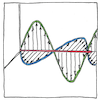Augustin-Jean Fresnel,
François Arago
optics

|
Wave optics
Sound waves vibrate longitudinally, that is, along the direction they travel. Thomas Young proposed that light waves were mainly longitudinal. But Augustin-Jean Fresnel worked with François Arago to establish the laws of interference between rays of polarized light, and realized, in order to explain polarization, that light waves were entirely transverse.
Fresnel lens
Fresnel took the idea of making a lighter lens with sections separated by stepwise discontinuities from Georges-Louis Leclerc, Comte de Buffon, or Nicolas de Caritat, marquis de Condorcet. As commissioner of lighthouses in France he designed a series of different-size lenses and was the first to build these large-aperture and short-focal-length lenses for lighthouses.
The principles
The basic principles survive and are reapplied in unanticipated contexts. Augustin-Jean Fresnel created an object of beauty for which each lens facet, each mount, each screw was made by hand to amaze for hundreds of years.



These laws about light waves were not obvious; Fresnel and Arago were brilliant experimenters and made clever prisms and filters to superimpose parallel and orthogonally polarized rays of light. Fresnel is also famous for a prism, the Fresnel rhomb, that converts linearly polarized light to circularly polarized light.
See also in The book of science:
Readings in wikipedia:
Other readings: